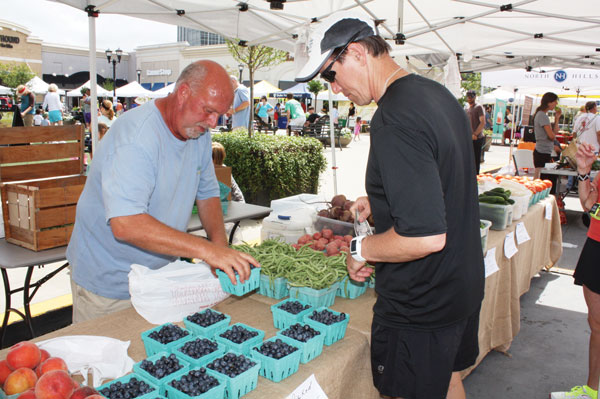July 26, 2013

The North Carolina blueberry crop was affected by the rainy spring, like most fruits and vegetables.
But the abundance of berries for sale at the North Carolina Farmers Market in Raleigh earlier this summer, showed that excessive rain or no, there were still plenty of berries to meet consumer demand.
This won’t, however, go down in history as a bumper crop. Four Oaks, N.C., farmer Scott Barefoot said the cold spring caused the loss of his first crop of blueberries. “Now some of our rabbiteye varieties are not sizing up due to lack of pollination,” Barefoot said at the Farmers Market.
It was hard to pick wet fruit, he said. And there was definitely a yield loss. “I would say we are looking at about a 70 percent crop so far,” said Barefoot, who grew 27 acres of blueberries this year. “But flavor and quality have been good.”
Much of the North Carolina crop had been harvested in less than ideal conditions, said Bill Cline, North Carolina Extension plant pathologist.
“In a perfect world, you would only harvest blueberries when they are dry,” said Cline. “But this season, we had to pick them when we could.”
But through the middle of June, it seemed that most of the crop was getting picked, he said. “I haven’t seen any fields abandoned. But it has been a struggle to get the berries out.”
It would have been a bigger challenge, except that a lot got picked ahead of the rain, he added.
Weather like 2013’s raises the possibility of quality problems that may affect the berries acceptance by the market, but Cline said he hadn’t heard of any blueberries getting rejected by buyers.
One practice that helped this year was planting multiple varieties with different maturity dates.
“Years ago, we planted almost entirely the Croatan variety,” said Cline. “It would all come off at one time, close to Memorial Day, and all would be subject to the same weather.”
Now farmers plant several varieties of differing maturity, and the harvest comes off in a series of small peaks.
Spreads the risk
“It’s a good practice — using variety choice to stagger harvest spreads your risk and also your market window,” he said.
Some of the varieties that have found a place in a staggered harvest program are the early varieties Star and O’Neal, the mid-season variety Legacy and the late variety Powderblue.
Some North Carolina growers had a problem this season with the fungal disease “mummy berry.” The disease doesn’t appear every year but did in 2013.
Mummy-infected berries appear in fruit up to the bloom stage.
“One fortunate thing about this disease is that it is really obvious which berries have it,” said Cline. “They are unsightly, and any color sorter will be able to kick them out. So a mummy berry rarely makes it to the grocery store. But it reduces the quality of the crop. “
In severe cases it can affect yield.
An affected blueberry does not turn blue, but is pink or salmon, said Cline. The interior is all hard fungal tissue.
What can you do about mummy berries?
“Where you see mummies fall to the ground, you should cultivate the ground and cover it so they don’t germinate and over-winter,” said Cline. “There are some good fungicides available to spray in the field, and there are also resistant varieties.”
The cool spring affected Tar Heel strawberries as well, extending the harvest season a few weeks. It would have been expected to end soon after a wave of 90 degree temperatures around June 13. (Strawberries do not normally tolerate high heat, and flowering begins to shut down when temperatures consistently reach 90 degrees F.)
Picking did end on many strawberry farms about that time. But thanks to one variety that can handle the heat, strawberry harvest in North Carolina was expected to last on some farms until the end of June, or close to it. The variety is the Camarosa which has proven to be “truly a remarkable variety for its heat tolerance, and the size of these very late berries,” said Barclay Poling, retired North Carolina Extension specialist.
There has been a downside to keeping harvest going into June with all its rain! “We know the crop shuts down if you don’t strip off the rain-damaged berries, but as soon as you do this very expensive clean-up, in would come another storm!” said Poling.
Chandleris the standard cultivar for U-pick producers in North Carolina. It is the most reliable variety for the upper Piedmont and western parts of the state, where temperatures stay cooler longer, as they did this year. Camarosa is more popular in the Coastal Plain.
You May Also Like




